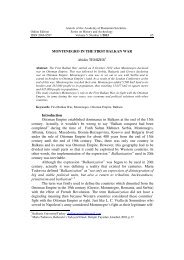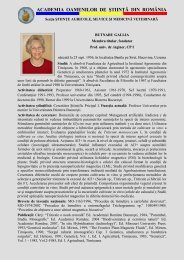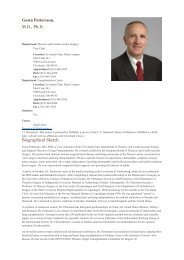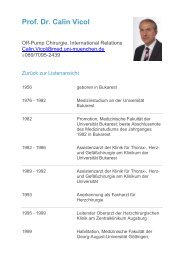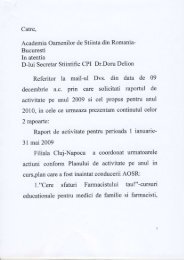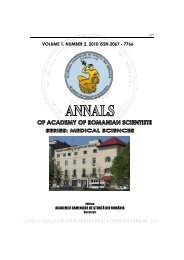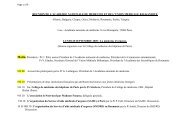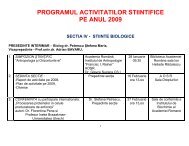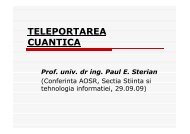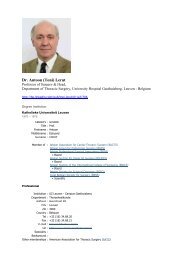114 Liviu Muresan, Septimiu CaceuAccor<strong>din</strong>g to the documents of the European Commission, critical infrastructuresinclu<strong>de</strong>: Installations and networks in the energy sector (especially the installationsfor producing electricity, oil and gas, installations for storage and refineries,transport and distribution systems); Communication and information (telecommunications, radio transmissionsystems, programs, the information materials and networks, inclu<strong>din</strong>g the Internetetc.);Finance (the banking sector, the stock market and the investments); Health care sector (hospitals, care equipments for patients and bloodbanks, pharmaceutics laboratories and products, emergency services, searchingand saving services); Food sector (security, production means, distribution and agro-alimentaryindustry);Water supply (reserves, storage, treatment and distribution systems); Transport (airports, ports, rail ways, mass transit networks, traffic controlsystems); Production, storage and transport of dangerous substances (chemical,biological, radiological and nuclear materials); Administration (basic services, installations, information networks, assets,important places, national monuments). Those infrastructures belong to the publicor private sector. This is why, in the conception of the European Commission, thepublic authority has to take the responsibility for consolidating and protectingthese infrastructures.To this, mo<strong>de</strong>rn communication networks are ad<strong>de</strong>d, inclu<strong>din</strong>g the Internet, thecomputer networks and the radio navigation through satellite.Due to interconnections and inter-conditioning, an attack on one criticalinfrastructure can have an effect, as “domino effect” on other criticalinfrastructures, amplifying, sometimes dramatically, the consequences.This inter<strong>de</strong>pen<strong>de</strong>nce brings about a significant rising of the vulnerabilities of theentire system and of all critical infrastructures. Therefore, it is highly possible,that paradoxically, in parallel to the process of European integration, the numberof critical infrastructures rises. This is yet another very important conclusion forthe analysis of critical infrastructures, with all their vulnerabilities and the threatsthey are facing continuous proliferation.Copyright © Editura Aca<strong>de</strong>miei <strong>Oamenilor</strong> <strong>de</strong> Știință <strong>din</strong> România, <strong>2011</strong>Watermark Protected
Critical Infrastructures ProtectionA <strong>Romania</strong>n Perspective (Part 1) 115However, the critical infrastructures know a certain dynamic, some can becomecritical, others, protected a<strong>de</strong>quately, can exit this category.The European Commission suggests three essential criteria for the i<strong>de</strong>ntificationof potentially critical infrastructures: Extent or surface. The <strong>de</strong>terioration of the critical infrastructure isevaluated <strong>de</strong>pen<strong>din</strong>g on the geographical region which would sufferconsequences; the international, national, regional/ territorial or local dimension; The <strong>de</strong>gree of seriousness. The inci<strong>de</strong>nce or <strong>de</strong>gradation can be null,minimal, mo<strong>de</strong>rate or high. The main criteria for the evaluation of the <strong>de</strong>gree ofseriousness: economic inci<strong>de</strong>nce, inci<strong>de</strong>nce on the public, inci<strong>de</strong>nce on theenvironment, <strong>de</strong>pen<strong>de</strong>nce, political inci<strong>de</strong>nce; Effect in time. This criterion shows the moment in which the <strong>de</strong>gra<strong>din</strong>g ofthe infrastructure can have a major inci<strong>de</strong>nce or a serious effect – immediately,after 24-48 hours, in a week or within a longer period of time.It is the duty of every state that it i<strong>de</strong>ntifies through the governmental structuresthe critical infrastructures on its territory. However, the European states are notalone, isolated, but in extremely tightly knit, complex relationships. The absolutein<strong>de</strong>pen<strong>de</strong>nce concept has disappeared a long time ago. Europe becomes more andmore inter<strong>de</strong>pen<strong>de</strong>nt and responsible for everything which is going on, not only ininternational relations, but also on the territory of each state.This is why the process of i<strong>de</strong>ntifying, analysing, evaluating and securing(protecting) critical infrastructures cannot be fragmented, and, even less, isolated.If a single state does not comply with its obligations to i<strong>de</strong>ntify, the criticalinfrastructures on its territory, and to take the necessary measures for themitigation of their vulnerabilities, for countering the threats and ensuring thenecessary protection and security standards, the effects will be felt, one way oranother, by all the other states. In other words, the responsibility for i<strong>de</strong>ntifying,evaluating, protecting and securing critical infrastructures becomes in the contextof increased inter<strong>de</strong>pen<strong>de</strong>ncy and the proliferation of threats, a vital aspect for thegood functioning of human society. This is another important conclusion for themanagement of critical infrastructure security.The international dimension of this responsibility resi<strong>de</strong>s in the following reality: Most of critical infrastructures, or those that can become critical,outreaches the geographical area of one state; The increase of the vulnerabilities of critical infrastructures of one state<strong>de</strong>termines, one way or another, the raising of vulnerabilities of all infrastructuresin the area and/or network;Copyright © Editura Aca<strong>de</strong>miei <strong>Oamenilor</strong> <strong>de</strong> Știință <strong>din</strong> România, <strong>2011</strong>Watermark Protected



